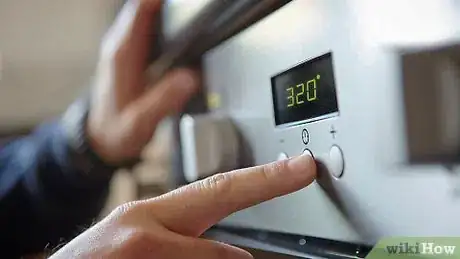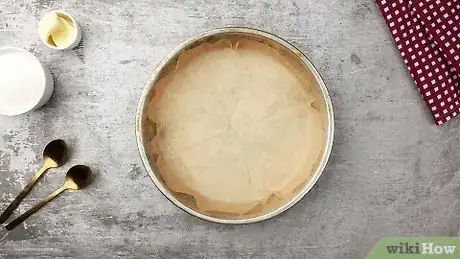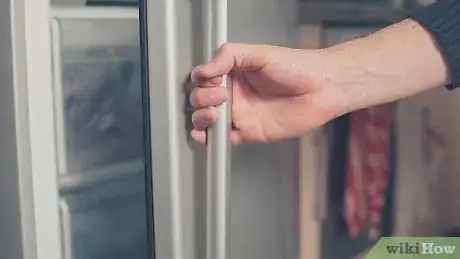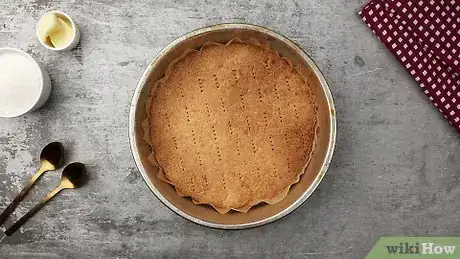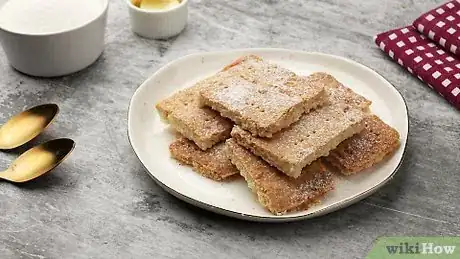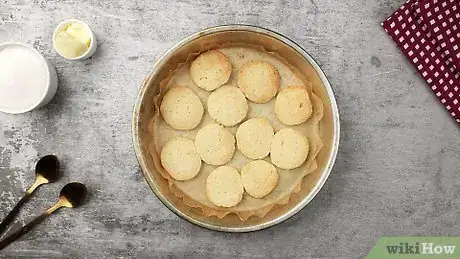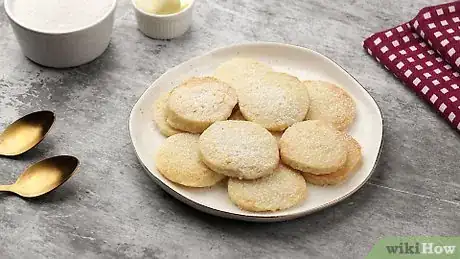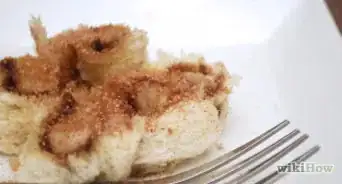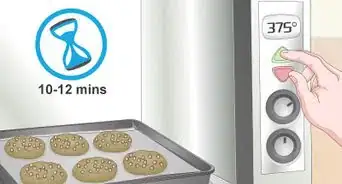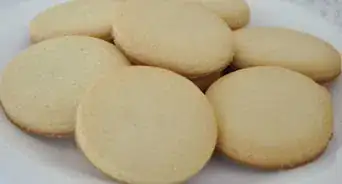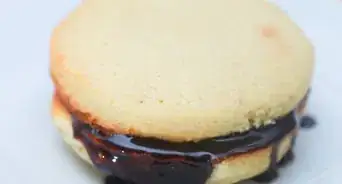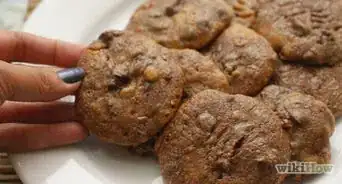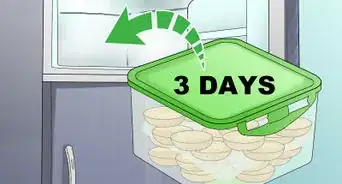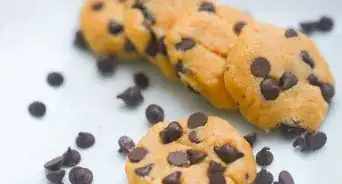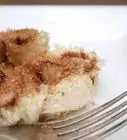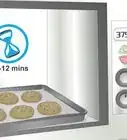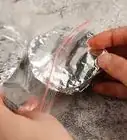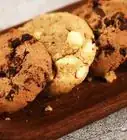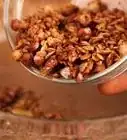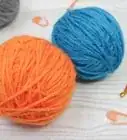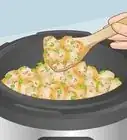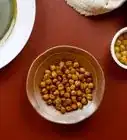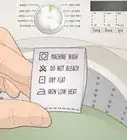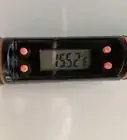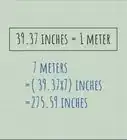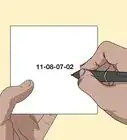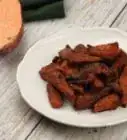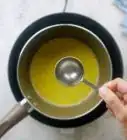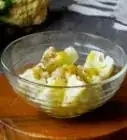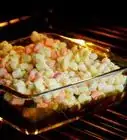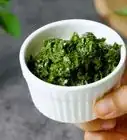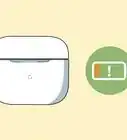This article was co-authored by Quynh La. Quynh La is a Professional Baker and the Owner of Sugar Bakery & Cafe in Seattle, Washington. With over seven years of experience, she specializes in baking cakes, cookies, croissants, and bread. Quynh holds an AAS in Culinary Arts from South Seattle College and a second AAS in Specialty Desserts & Bread from Seattle Central College.
There are 11 references cited in this article, which can be found at the bottom of the page.
This article has been viewed 170,852 times.
Shortbread is a delightfully rich and textured Scottish tradition. The simple version of this recipe is so easy you can memorize it: 1 part sugar, 2 parts butter, 3 parts flour. The version below goes a little further to improve the texture and ensure the dough cooks properly. Both wedges ("petticoat tails") and rounds use the same recipe.
Ingredients
- 115g / ½ cup European-style salted butter
- 55g / ¼ cup sugar (caster/superfine, icing/powdered, or granulated)
- 130g / 1 cup plain flour (all-purpose flour)
- 40g / ¼ cup rice flour or additional plain flour
Steps
Making the Shortbread Dough
-
1Prepare the oven. Preheat the oven to 160ºC (320ºF) and place a rack in the center position.
-
2Add cool butter to a mixing bowl. Take 115g (½ cup) salted butter on the cool side of room temperature, workable but not melting. Cut it into small chunks and add to a mixing bowl.[1]
- Most of the flavor of shortbread comes from butter, so using a fresh, high-quality product can make a big difference. The traditional choice is a European-style butter, which has a little more fat than American-style.[2]
- If you only have unsalted butter, just add a pinch of salt to the recipe. It won't mix in quite as well since shortbread dough is so dry, but it's not a major problem.[3]
Advertisement -
3Cream the butter and sugar together.[4] The recipe calls for 55g (¼ cup) sugar, but which type you use depends on your preferred texture. The most popular choices are caster sugar, for a sandy texture, or icing sugar, for a smooth, melt-in-your-mouth shortbread.[5] Whichever you choose, add the sugar gradually as you beat it into the butter, until light and fluffy.
- This takes about three minutes with an electric mixer's paddle attachment on low speed, or a bit longer by hand.[6]
- In the U.S. and some other countries, caster sugar is called "superfine", and icing sugar is "powdered" or "confectioner's."
- You may use granulated sugar, but the recipe sometimes ends up a little gritty.
-
4Sift in flour and mix into a dough.[7] Sift 130g (1 cup) plain flour and 40g (¼ cup) rice flour together to remove all lumps. Mix this into the butter mixture just long enough for it to form a soft, crack-free dough.[8] If this takes more than six or seven minutes, slowly dribble in water, but no more than 15 mL / 1 tbsp.[9]
- Electric mixers and food processors can overwork the dough, making it tough. If you use one, keep it on low and finish it by hand.[10] The warmth of your hands helps bind the dough together.
- Rice flour (also sold as ground rice or rice powder) encourages the signature sandy texture. In a pinch, the shortbread should still turn out fine if you replace it with additional ordinary flour.[11]
Baking Shortbread Wedges
-
1Line a circular pan with parchment paper. Let the paper hang over the edges so you can easily remove the shortbread. A single batch of this recipe should fit a 15cm (6 inch) pan.[12]
-
2Pat the dough gently into the pan. Press the dough into the pan and pat it flat, minimizing the handling time. If you'd like a smoother surface, cover the dough with plastic wrap and roll over it gently with a pastry roller or a lightweight jar.[15]
-
3Chill the dough (recommended). Cover the pan in plastic wrap and put it in the fridge for fifteen minutes (or even a full hour, if you're a perfectionist).[16] This will improve the texture of the shortbread.
-
4Score dotted lines with a fork. Poke the top of the shortbread with a fork, outlining eight or sixteen wedge-shaped slices on the surface. Poke the surface of each slice in several places as well. Besides looking decorative, these holes allow steam to escape, preventing cracking or bubbling.[17]
- This wedge shape is a traditional presentation for shortbread, called "petticoat tails."[18]
-
5Bake for 35–60 minutes. The shortbread is ready at the very first sign of golden brown at the edge, or even just before. It will take longer to bake in a smaller pan, since the dough is thicker.
-
6Cut and let cool. Let cool for a few minutes, then transfer out of the pan using parchment paper. Cut into slices while still warm, using a knife or pizza roller. Place slices onto a cooling rack to cool to room temperature, then serve or refrigerate in an airtight container.
- Optionally, sprinkle with extra sugar.
Baking Shortbread Rounds
-
1Pat into a log shape. Form the dough into a log with your hands, with minimal handling. You'll be slicing this log into rounds, so estimate the size of biscuit you'd like to make.
- If your hands are warm, it's best to avoid further handling of the dough. Instead, roll the dough onto parchment paper and cut out rounds with cookie cutters. Dust the rolling pin with icing sugar instead of flour, if you have it.[19]
-
2Let chill in the refrigerator. Cover the dough in plastic wrap and place in the fridge. Let chill for at least fifteen minutes, preferably 30 to 60, in order to prevent spreading in the oven.[20]
-
3Slice into rounds. The thickness can be anywhere from 5mm (1/5") for crisp biscuits, to 12mm (nearly 1/2") for chewy, soft-in-the-center rounds.
-
4Poke the tops with a fork. Poke a fork once or twice into the top of each round. This lets steam escape through the holes instead of bubbling or breaking the shortbread.
-
5Bake for about 15 minutes. Place the rounds on a lined baking tray. Check on them around the 12 minute mark, especially if the round are thin. They are ready when set but still pale, or when pale golden if you prefer them crisp. Remove them immediately if they look brown, since the underside cooks faster than the top.
-
6Let cool before eating. Transfer to a wire rack and let cool. Sprinkle in sugar before eating for a sweeter, sparkling biscuit.
- Pack leftovers in an airtight tub and eat within a couple weeks.[21]
Community Q&A
-
QuestionHow would you make pretty designs on the dough for a party?
 Community AnswerThere are thousands of shape cutters available that will do this. There are also rolling pins with stamps on them. Check your local stores.
Community AnswerThere are thousands of shape cutters available that will do this. There are also rolling pins with stamps on them. Check your local stores. -
QuestionCan I use plain flour instead of rice flour?
 Community AnswerYes, and they cookies will turn out fine; rice flour is just more ideal as it makes a better cookie.
Community AnswerYes, and they cookies will turn out fine; rice flour is just more ideal as it makes a better cookie. -
QuestionCan I use self-rising or chapatti flour?
 Community AnswerNo, you can't use those flours as they won't result in the correct shortbread texture.
Community AnswerNo, you can't use those flours as they won't result in the correct shortbread texture.
References
- ↑ http://www.kingarthurflour.com/recipes/shortbread-recipe
- ↑ http://bakingbites.com/2008/02/are-european-style-butters-better/
- ↑ http://www.kingarthurflour.com/blog/2008/12/15/a-solstice-celebration-shortbread/
- ↑ Quynh La. Professional Baker. Expert Interview. 11 March 2022.
- ↑ http://www.foodlovers.co.nz/features/baking-perfect-shortbread.html
- ↑ http://www.seriouseats.com/recipes/2012/04/best-butter-shortbread-cookie-recipe.html
- ↑ Quynh La. Professional Baker. Expert Interview. 11 March 2022.
- ↑ https://www.rivercottage.net/recipes/shortbread
- ↑ http://www.kingarthurflour.com/blog/2008/12/15/a-solstice-celebration-shortbread/
- ↑ http://www.seriouseats.com/recipes/2012/04/best-butter-shortbread-cookie-recipe.html
- ↑ http://www.theguardian.com/lifeandstyle/wordofmouth/2010/sep/30/how-to-make-perfect-shortbread
- ↑ http://www.theguardian.com/lifeandstyle/wordofmouth/2010/sep/30/how-to-make-perfect-shortbread
- ↑ http://www.craftsy.com/blog/2014/01/how-to-make-perfect-shortbread/
- ↑ http://www.scottish-at-heart.com/scottish-shortbread-recipe.html
- ↑ http://www.kingarthurflour.com/blog/2008/12/15/a-solstice-celebration-shortbread/
- ↑ http://www.seriouseats.com/recipes/2012/04/best-butter-shortbread-cookie-recipe.html
- ↑ http://www.craftsy.com/blog/2014/01/how-to-make-perfect-shortbread/
- ↑ http://www.scottish-at-heart.com/scottish-shortbread-recipe.html
- ↑ http://www.thecomfortofcooking.com/2013/11/3-ingredient-shortbread-cookies.html
- ↑ http://www.foodlovers.co.nz/features/baking-perfect-shortbread.html
- ↑ http://www.craftsy.com/blog/2014/01/how-to-make-perfect-shortbread/
About This Article
To make shortbread, first preheat your oven to 325°F (163°C). Then, add 2 cups (250 g) of flour and 2/3 cup (150 g) of granulated sugar to a food mixer or bowl. Mix in 3/4 teaspoon (4 g) of salt and 2 sticks of butter until it separates into crumbly, pea-sized balls of dough that stick together. Next, transfer the dough to an ungreased baking pan and flatten it by hand or with a rolling pin. Prick the surface of the dough with a fork once every 2-4 inches (5-10 cm) so that steam can escape and your shortbread bakes evenly. Bake the dough on the center rack for 40-50 minutes or until the top turns golden brown. Transfer the dough to a wire rack and let it cool off for 5-10 minutes. Finally, cut the dough into squares, rectangles, or triangles and enjoy! For help making shortbread wedges or rounds, read on!
